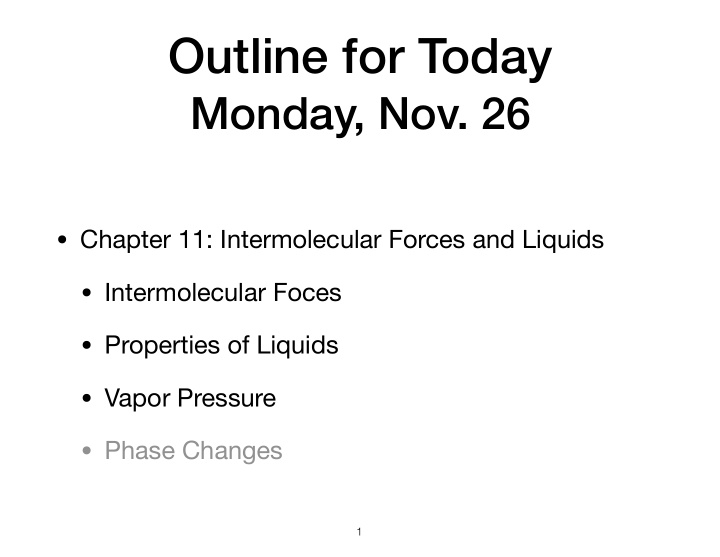



Outline for Today Monday, Nov. 26 • Chapter 11: Intermolecular Forces and Liquids • Intermolecular Foces • Properties of Liquids • Vapor Pressure • Phase Changes � 1
Intermolecular Forces • London Dispersion : Attraction between momentary or instantaneous dipoles in molecules. • Dipole-Dipole : Attraction between partial charges due to permanent dipoles • Hydrogen-Bonding : Attraction between partial charges on H-F , H-O, or H-N bonds. • Ion-Dipole : Attraction between ions and partial charges of dipoles
Review of London Dispersion
Dipole-Dipole • Dipole-Dipole: Attraction between partial charges due to permanent dipoles. • Example: Is there a dipole on CH 3 CN? • How do the dipoles interact?
Dipole-Dipole Interactions in Solids
Dipole Dipole Interactions in Liquids
The larger the dipole, the stronger the dipole-dipole interactions! O O N Increasing Polarity Increasing Dipole-Dipole Interactions Increasing Boiling Point
Hydrogen-Bonding is a special type of dipole interaction • Hydrogen-Bonding : Attraction between partial charges on H-F , H-O, or H-N bonds. • H-F , H-N, and H-O are especially polar bonds! • They interact strongly with small electronegative ions or atoms (like F , O, or N of another molecule). • That interaction is called hydrogen bonding.
NOT A Hydrogen Bond H H H C H H C H H H Yes, there are hydrogens bonded to stu ff … BUT there are no intermolecular hydrogen bonding interactions . There is no hydrogen bond.
Hydrogen Bonding Is Critical for Understanding the Properties of Water!
Predict the relative strengths of the dipole-dipole interactions • Order the following by increasing boiling point (based on strength of the intermolecular interactions) O O c) 2-Methylpropane a) Butane b) Propyl alcohol d) Isopropyl alcohol
Intermolecular Forces with Charged Particles • Ion-Dipole Forces : Attraction (or Repulsion) between an ion and the partial charge on the end of a molecule
Try this chart with: Ammonia, Methane, Acetic Acid, Hydrochloric Acid
Comparing IMFs for different molecules • When molecules of two substances have similar molecular weights : • Their dispersion forces are about equal. • Use dipole-dipole interactions to determine IMF strength. • Example: CH 3 COOH vs. CH 3 CH 2 CH 2 OH H O H H H H H C O H vs. H C C C O C H H H H Boiling 118 o C 97 o C Temperature:
Comparing IMFs for different molecules • When molecules of two substances have very di ff erent molecular weights and there is no hydrogen bonding: • Dispersion forces tend to be more important in determining strength of IMF . • The higher the molecular weight the stronger the IMFs. • Example: CCl 4 vs. C 8 H 18 CCl 4 C 8 H 18 Molecular Mass 154 g/mol 257 g/m 76 o C 135 o C Boiling Point
Properties of Liquids: Viscosity • Viscosity : A substance’s resistance to flow • Stronger intermolecular forces = More Viscous • Example: Pitch Drop Experiment
Properties of Liquids: Surface Tension • Surface Tension: Energy required to increase surface area by a given amount • Stronger the intermolecular forces, there greater the surface tension.
Properties of Liquids: Capillary Action • Cohesive Forces: intermolecular forces that bind a substance to itself • Adhesive Forces: intermolecular forces that bind a substance to a surface • Capillary Action occurs when adhesive force is greater than cohesive force.
Examples of Capillary Action • Shape of a meniscus in a glass test tube
Phase Changes
Vapor Pressure • Vapor Pressure: the partial pressure of the vapor when it is in dynamic equilibrium with the liquid • Dynamic Equilibrium: Two opposing processes occur simultaneously at equal rates gas ➞ liquid at the same time! liquid ➞ gas
Dynamic Equilibrium and Vapor Pressure
Volatility • Volatility: How easily a liquid evaporates. • A molecule is more volatile and has a higher vapor pressure if it has weaker intermolecular forces.
Volatility Examples • Why does hot water evaporate more quickly than cold water? • Why does liquid nitrogen evaporate more quickly than water?
Vapor Pressure and Boiling Point
Heating Curves and Phase Changes
Phase Diagrams
Phase Diagrams: How To Read Them Given two independent variables: P and T… what is the dependent variable, the phase or state of matter?
Phase Diagram for CO 2
Phase Diagram for H 2 O
Recommend
More recommend